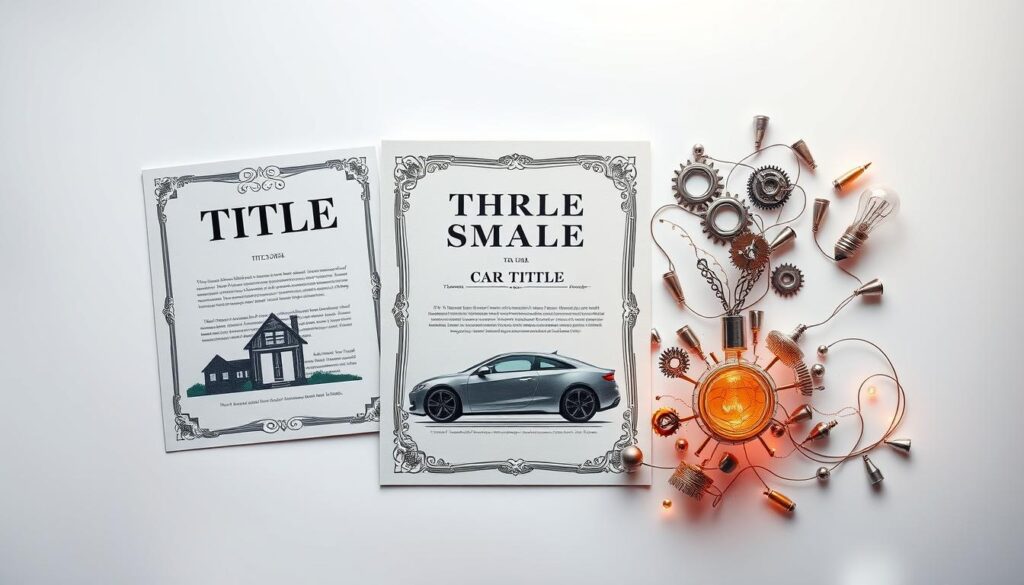Owning property is a big deal for health-conscious men over 40. It could be a family home, a beloved car, or a valuable patent. But, the legal side of owning property can be tricky. This guide will help you understand property titles, from the basics to how they work today.
At the heart of owning property is the title. It’s like a legal ID card for your stuff. It shows who owns things like houses, cars, trademarks, and patents. Knowing how titles work is key for men who want to keep their assets safe and in good shape.
Understanding the Fundamentals of Property Titles
Getting into property ownership means knowing about property titles. These titles have a long history, from ancient times to today. They are key in making sure who owns a piece of land.
Origins and Basic Concepts
Property titles started in ancient times. Back then, laws were made to handle land and other assets. Today, they help protect your rights to a property.
Key Components and Functions
A property title is a legal document showing who owns a piece of land. It’s important to know the difference between a clear title and an encumbered title. This helps you understand the real estate market better.
Modern Applications
Nowadays, property titles do many things. They help with title searches and make sure property rights are transferred when selling or inheriting. Knowing about property titles helps men in their 40s make smart real estate choices.
Essential Types and Classifications of Titles
In the world of real estate, vehicles, and intellectual property, titles are key. They show who owns something and what rights come with it. Let’s look at the main types and classifications of titles that people and companies need to know.
Real Estate Titles: Real estate titles vary, each with its own meaning. Tenancy in common means many people share a property. Joint tenancy means shared ownership with a right of survivorship. Sole ownership gives one person full control over a property.
Car Titles: A car title shows who owns a vehicle. A clear title means the car is free of any loans or legal problems. It can be sold or transferred. Junk titles are for cars that are considered a total loss. Reconstructed titles are for cars that have been fixed and are safe to drive again.
Intellectual Property Titles: Intellectual property, like trademarks and patents, also needs specific titles. Trademarks protect a brand’s identity. Patents give exclusive rights to inventions. Copyrights protect original creative works, letting creators control their work.
| Title Type | Definition | Implications |
|---|---|---|
| Tenancy in Common | Multiple owners hold a share of the property | Flexible ownership structure, can be transferred or inherited independently |
| Joint Tenancy | Shared ownership with the right of survivorship | If one owner dies, the remaining owner(s) inherit the property |
| Sole Ownership | A single individual holds complete control over the property | The owner has full decision-making power and can freely transfer or sell the property |
| Clear Title | Vehicle is free of any outstanding loans or legal issues | The vehicle can be easily transferred or sold |
| Junk Title | Vehicle has been declared a total loss | The vehicle cannot be legally driven and may have limited resale value |
| Reconstructed Title | Vehicle has been repaired and restored to a roadworthy condition | The vehicle can be registered and driven, but may have a lower resale value |
| Trademark | Unique brand identity or logo | Provides legal protection and exclusive rights to the brand |
| Patent | Exclusive rights to an invention or innovation | Grants the inventor or owner the exclusive right to use, manufacture, or sell the patented item |
| Copyright | Exclusive rights to original creative works | Ensures the creator or owner can control the use and distribution of their work |
Knowing about different titles helps people and companies deal with real estate, cars, and intellectual property better. This knowledge helps make smart choices and protect important assets and rights.

Legal Aspects and Documentation Requirements
Understanding property titles involves knowing the laws, documents, and rules. We’ll explore key points to help property owners keep their rights and meet their legal duties.
Regulatory Frameworks
Property laws change by place. It’s key for owners to know the laws in their area. These laws set out what documents and steps are needed for property titles.
Documentation Standards
Good documents are vital for a valid property title. From buying to selling, title documentation must be kept up to date. This includes deeds, mortgage papers, and title insurance.
Compliance Requirements
- Keep documents for at least 7 years: Laws say suppliers must keep property laws and title documentation for 7 years after service.
- Make sure coding and billing are right: Auditors check if services match medical records. This ensures payments are correct.
- Follow coverage rules: NCDs and LCDs say what services are needed. These rules must be in title documentation.
Knowing and following these rules helps property owners deal with property titles confidently. It also protects their rights.
Transfer and Ownership Rights
Understanding property ownership and title transfer is key for real estate and inheritance planning. The process of transferring titles can be complex. It needs a good grasp of the legal aspects and possible issues.
A clear title means the owner has no claims or liens. It’s vital before selling or inheriting property. An encumbered title can lead to legal fights and costs.
| Object Type | Ownership Transfer Allowed |
|---|---|
| Tables, Views, Procedures, Schemas, Sequences | Yes |
| Application Role, Connection | No |
The GRANT OWNERSHIP command is key for transferring database object ownership. It ensures the new owner has control and access. But, some objects, like application roles, can’t be transferred.
- Transferring ownership may need REVOKE or COPY CURRENT GRANTS to manage privileges.
- Ownership transfer only affects objects existing at the time of the command. New objects are owned by the creator.
- Pausing or suspending objects might be needed for transferring ownership of certain types.
Real property includes land and subsurface rights. Personal property, like cash and household items, can also have ownership claims. Knowing the differences is key for protecting your rights.
Successfully handling title transfer and ownership rights requires understanding the law and challenges. Being informed and proactive helps ensure a smooth property transfer, whether through sale or inheritance.
Common Challenges and Solutions
Dealing with property titles can be tricky. You might face issues like title defects, liens, or disputes over who owns the property. But, with the right steps and precautions, you can get past these problems.
Identifying Title Issues
It’s key to do deep title searches and checks. This helps find hidden problems like liens, encumbrances, or mistakes in who owns the property. By tackling these title defects early, you can lower risks and make sure your ownership is secure.
Resolution Strategies
Fixing title problems usually means working with lawyers and title companies. You might need to talk to lienholders or go to court to clear up ownership. If there’s a fight over who owns the property, mediation or lawsuits might be needed.
Preventive Measures
Getting title insurance is a smart move to avoid future problems. It protects you from financial losses due to title issues. Keeping your property records current also helps avoid and fix title problems quickly.









